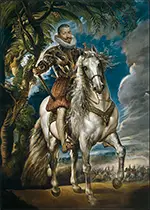King Philip III of Spain
Part 1: Big Shoes to Fill
He was born in Madrid on April 14, 1578. His father was the reigning monarch, King Philip II. His mother was Anna of Austria, the king's fourth wife. Philip the king wanted Prince Philip to have a good education in the ways of the world as well as in studies, so he also employed his military teacher, the Castilian soldier Juan de Zúñiga, to instruct the young heir apparent. For more wide-ranging studies, young Philip learned from García de Laysa and Cristóbal de Moura. The boy proved more adept at learning languages than his father had been, learning (and remembering) French, Latin, and Portuguese–in addition to Spanish, of course. He also developed a love of hunting that he never lost. 
One person that young Philip met while he was a teenager was Francisco Gómez de Sandoval y Rojas, the Marquis of Denia. The two became friends but King Philip II disapproved of the man and sent him away from the Madrid court, installing him as a viceroy in Valencia in 1595. Denia returned two years later, when the king was ailing. When Philip II died, in 1598 and his son succeeded him as King Philip III, the new monarch named his former friend as his chief advisor. The following year, Philip named him the Duke of Lerma, the name by which he is most well-known. Spain had been at war, off and on, with several European powers for most of Philip II's reign. As Prince Philip was growing up, Spanish forces were heavily involved in the French Wars of Religion, in the Italian Wars, and in putting down a revolt in the Spanish Netherlands. Also, in 1581, a Spanish army had vanquished a Portuguese army and Philip had absorbed Portugal into his realm, styling himself King Philip I of Portugal. Thus, when Philip II died, King Philip III was king of not only Spain but also Portugal and the former Italian territories of Naples, Sardinia, and Sicily. Philip was also Duke of Milan. One thing that he didn't have to worry about immediately on his ascension was further war with France: His father had concluded peace with that foe not long before he died. As the 17th Century began, Spain and the Low Countries were still at war, but the fighting was taking place mainly around the borders. In the main centers, trade and economy flourished. Dutch ships sailed far and wide, powering the enterprise of the Dutch East India Company, created in 1602. Dutch ships also attacked overseas colonies belonging to Portugal, which Philip had absorbed into his empire earlier in his reign. Spain was forced to spread its resources ever more thinly. By 1609, both sides realized that the borders were probably set: in the north were the Protestant Netherlands, and in the south were the Spanish (Catholic) Netherlands. By that time, Philip II had died and been replaced on the Spanish throne by his son, Philip III. Representatives of the two sides met at The Hague and hammered out a ceasefire, to last a decade and two years. This was the Twelve Years Truce. All of those military conflicts had drained the Spanish treasury, despite a regular influx of gold and silver from the New World, and Philip III took the reins with his country in need of revenues. Adding to the difficulties were a handful of awful harvests contributed to famines and a wave of bubonic plague. Philip had inherited his father's piety (and is known by many as Philip the Pious) but not his father's desire for military and political intrigue. Very quickly after taking power, Philip named the Duke of Lerma valido (royal favorite) and told his other advisors to obey Lerma as if he were the king. Philip was only too happy to withdraw from court life and get busy hunting, praying, and having children. Next page > Legacy-building > Page 1, 2 |
|
Social Studies for Kids
copyright 2002–2024
David White



 Philip III was King of Spain for more than two decades at the beginning of the 17th Century. He inherited a vast empire from his father but is known more for his disinterest in such matters.
Philip III was King of Spain for more than two decades at the beginning of the 17th Century. He inherited a vast empire from his father but is known more for his disinterest in such matters.
